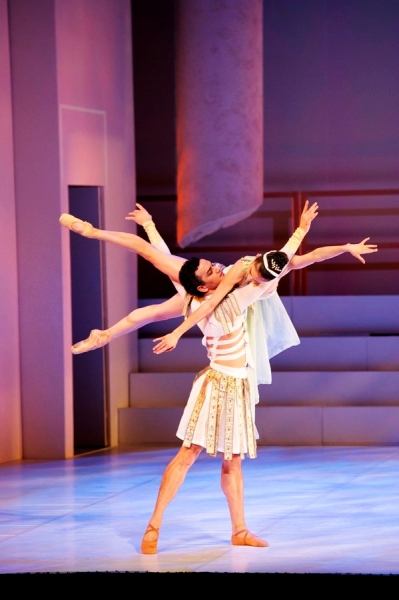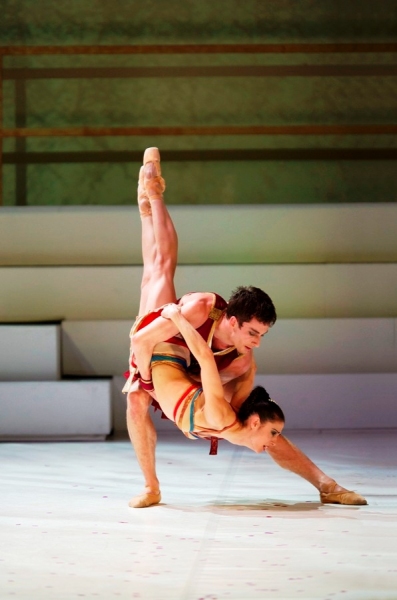Cleopatra, Northern Ballet, Sadler's Wells | reviews, news & interviews
Cleopatra, Northern Ballet, Sadler's Wells
Cleopatra, Northern Ballet, Sadler's Wells
A romping, stomping, pleasure of a show, and a design dazzler
David Nixon has been artistic director of Northern Ballet for a decade, and it’s probably safe to say he is the king of the story ballet: Wuthering Heights, Les Liaisons Dangereuses, Madame Butterfly, Dracula – if it’s got a story, he is, seemingly, willing to tell it. As Christopher Wheeldon’s recent Alice in Wonderland for the Royal Ballet showed, this is not as easy as might first appear. Nixon shoots straight from the hip: he is interested in narrative, he loves answering the question, “What happened then?”
In Cleopatra, of course, it’s more a question of what didn’t happen to her: in childhood married to her brother, as was the custom, his death left her vulnerable to warring factions. As the Romans invaded, she threw in her lot with, and entranced, Julius Caesar, who protected her throne for her; on his death, she moved on to his lieutenant, Mark Antony; when their forces were routed by Octavian, Antony and then Cleopatra killed themselves, rather than submitting to the degradation of being prisoners in a Roman triumph.
The astonishing thing is, Nixon pretty well manages to tell that story. Of course, it has been told endlessly, from Shakespeare, to Shaw, to Joseph Mankiewicz. And it has been played endlessly, too, culminating in our cultural memories, perhaps, most enduringly in Elizabeth Taylor’s astonishingly kitsch 1963 film. Certainly this has made an impression on Nixon and his team, who do far more than nod in the film’s direction; Shakespeare, too, contributes his references. (Shaw they seem to have skipped.) Nixon is blessed with a strong, stalwart Cleopatra in Martha Leebolt (pictured left, with Javier Torres as Julius Caesar). As she moves through the melodrama that is her life, she links first with the admirable Javier Torres, then with the louche Tobias Batley (pictured below, with Leebolt) as Antony succumbing to the seductive lures of ancient Egypt, even while he keeps his jetés nice and crisp.
Nixon is blessed with a strong, stalwart Cleopatra in Martha Leebolt (pictured left, with Javier Torres as Julius Caesar). As she moves through the melodrama that is her life, she links first with the admirable Javier Torres, then with the louche Tobias Batley (pictured below, with Leebolt) as Antony succumbing to the seductive lures of ancient Egypt, even while he keeps his jetés nice and crisp.
But the real stars of the show are the design team: Christopher Giles (design), Tim Mitchell (lighting) and Nina Dunn (projection design). Together they have produced a wonderfully flexible touring set (main picture, above), which produces all the drama and variation needed for the alternating Roman and Egyptian scenes. We begin in a temple, honey-gold, as Cleopatra prays to the snake god Wadjet (a somewhat stiffly un-snake-like Giuliano Contadini); we then move to a white-washed minimal set, which is enchantingly covered with brightly coloured Egyptianate decorations via projections; the Roman scenes, when Cleopatra has a foreboding vision of doom, shockingly have pillars and walls running with blood. And the final transfiguration, after death, when Cleopatra joins the Egyptian gods in posthumous elevation, is a brilliantly clean white light, with gold and silver shadowings: a really fine design moment that ends the entire ballet on a moment of transcendence. If there is criticism to be made, it is that the characterisations are not strong – there is virtually no difference in dance vocabulary between Cleopatra and Antony’s wife Octavia, so their struggle to win him seems pallid, and in dance terms a matter of little moment as to who wins. Equally, the replacement of Julius Caesar with Antony in Cleopatra’s bed seems to matter little: the story is in effect a recapitulation because the men have nothing to distinguish one from the other. And the entire war of the Romans versus the Egyptians has vanished: Cleopatra's tragedy has become personal, and you wouldn't know from her duet with Antony at the end that between them they have lost an empire. This removes the overwhelming arc of tragedy that is there in all the really great retellings of the story - Nixon's story is instead one about a woman who got carried away, not one who destroyed a world. Which makes it, finally, a good show, not great art.
If there is criticism to be made, it is that the characterisations are not strong – there is virtually no difference in dance vocabulary between Cleopatra and Antony’s wife Octavia, so their struggle to win him seems pallid, and in dance terms a matter of little moment as to who wins. Equally, the replacement of Julius Caesar with Antony in Cleopatra’s bed seems to matter little: the story is in effect a recapitulation because the men have nothing to distinguish one from the other. And the entire war of the Romans versus the Egyptians has vanished: Cleopatra's tragedy has become personal, and you wouldn't know from her duet with Antony at the end that between them they have lost an empire. This removes the overwhelming arc of tragedy that is there in all the really great retellings of the story - Nixon's story is instead one about a woman who got carried away, not one who destroyed a world. Which makes it, finally, a good show, not great art.
But the corps perform with ardour their romping, stomping war scenes in particular – the chaos unleashed after the Ides of March, and the Roman invasion that brings Antony back to Egypt - and they are backed well at these points by Claude-Michel Schönberg’s music, which in the more lyrical moments does become filmicly clichéd. As an overall show, however, Cleopatra is a pleasure to watch, moving with pace, style and a great deal of panache.
- Northern Ballet's Cleopatra, at Sadler's Wells to 21 May
- See what's on at Sadler's Wells. Read Sadler's Wells show reviews
- Northern Ballet Theatre's touring season dates
Share this article
more Dance
 MacMillan Celebrated, Royal Ballet review - out of mothballs, three vintage works to marvel at
Less-known pieces spanning the career of a great choreographer underline his greatness
MacMillan Celebrated, Royal Ballet review - out of mothballs, three vintage works to marvel at
Less-known pieces spanning the career of a great choreographer underline his greatness
 Carmen, English National Ballet review - lots of energy, even violence, but nothing new to say
Johan Inger's take on Carmen tries but fails to make a point about male violence
Carmen, English National Ballet review - lots of energy, even violence, but nothing new to say
Johan Inger's take on Carmen tries but fails to make a point about male violence
 WAKE, National Stadium, Dublin review - a rainbow river of dance, song, and so much else
THISISPOPBABY serves up a joyous tapestry of Ireland contemporary and traditional
WAKE, National Stadium, Dublin review - a rainbow river of dance, song, and so much else
THISISPOPBABY serves up a joyous tapestry of Ireland contemporary and traditional
 Swan Lake, Royal Ballet review - grand, eloquent, superb
Liam Scarlett's fine refashioning returns for a third season, and looks better than ever
Swan Lake, Royal Ballet review - grand, eloquent, superb
Liam Scarlett's fine refashioning returns for a third season, and looks better than ever
 First Person: Ten Years On - Flamenco guitarist Paco Peña pays tribute to his friend, the late, great Paco de Lucía
On the 10th anniversary of his death, memories of the prodigious musician who broadened the reach of flamenco into jazz and beyond
First Person: Ten Years On - Flamenco guitarist Paco Peña pays tribute to his friend, the late, great Paco de Lucía
On the 10th anniversary of his death, memories of the prodigious musician who broadened the reach of flamenco into jazz and beyond
 Dance for Ukraine Gala, London Palladium review - a second rich helping of international dancers
Ivan Putrov's latest gala was a satisfying mix of stars and young hopefuls
Dance for Ukraine Gala, London Palladium review - a second rich helping of international dancers
Ivan Putrov's latest gala was a satisfying mix of stars and young hopefuls
 Nelken: A Piece by Pina Bausch, Sadler's Wells review - welcome return for an indelible classic
A new generation of gifted performers for us to get to know
Nelken: A Piece by Pina Bausch, Sadler's Wells review - welcome return for an indelible classic
A new generation of gifted performers for us to get to know
 Dark With Excessive Bright, Royal Ballet review - a close encounter with dancers stripped bare
The Royal's Festival of New Choreography launches with an unforgettable walk in the dark
Dark With Excessive Bright, Royal Ballet review - a close encounter with dancers stripped bare
The Royal's Festival of New Choreography launches with an unforgettable walk in the dark
 La Strada, Sadler's Wells review - a long and bumpy road
Even the exceptional talents of Alina Cojocaru can't save dance adaptation of Fellini film
La Strada, Sadler's Wells review - a long and bumpy road
Even the exceptional talents of Alina Cojocaru can't save dance adaptation of Fellini film
 First Person: pioneering juggler Sean Gandini reflects on how the spirit of Pina Bausch has infiltrated his work
As Tanztheater Wuppertal Pina Bausch's 'Nelken' comes to Sadler’s Wells, a tribute from across the art forms
First Person: pioneering juggler Sean Gandini reflects on how the spirit of Pina Bausch has infiltrated his work
As Tanztheater Wuppertal Pina Bausch's 'Nelken' comes to Sadler’s Wells, a tribute from across the art forms
 Manon, Royal Ballet review - a glorious half-century revival of a modern classic
Fifty years on, Kenneth MacMillan's crash-and-burn anti-heroine is riding high
Manon, Royal Ballet review - a glorious half-century revival of a modern classic
Fifty years on, Kenneth MacMillan's crash-and-burn anti-heroine is riding high
 Giselle, English National Ballet, Coliseum review - if you go down to the woods today, beware of the Wilis
A revival of Mary Skeaping's lovingly researched production, packed with lively detail and terrific suspense
Giselle, English National Ballet, Coliseum review - if you go down to the woods today, beware of the Wilis
A revival of Mary Skeaping's lovingly researched production, packed with lively detail and terrific suspense

Add comment